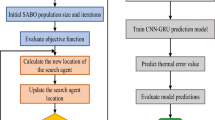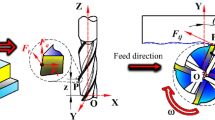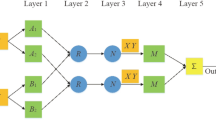Abstract
Estimation of energy consumption in machining plays an irreplaceable role in monitoring and improving energy efficiency with reduced emission and surface roughness. This paper proposed a novel data-based grey online modeling and monitoring system for the power consumption, aerosol emissions, and surface roughness in wire cut electrical discharge machining of Ti-6Al-4 V using the grey theory GM(1,N). The proposed methodology needs a very less number of data samples for modeling and monitoring with no training time. Amplitude of wire vibration in X- and Y-directions and absolute difference of wire amplitude in data series are inputs for the grey online modeling and monitoring system. The root mean square error for different parameter settings is estimated and identified as an optimum combination of parameters. The combination of amplitude of wire vibration in X-direction and absolute difference of wire amplitude in X- and Y-directions is significant in estimation of power consumption (root mean square error is 0.81) as well as aerosol emissions (root mean square error is 0.75), and the combination of amplitude of wire vibration in Y-direction and absolute difference of wire amplitude in X- and Y-directions is significant in estimation of surface roughness (root mean square error is 0.41). An artificial neural network is also developed and trained with a feedforward backpropagation algorithm that predicted the power consumption, emissions, and surface roughness. A comparison between the grey online modeling and monitoring system and the system developed by the neural network found that grey online modeling and monitoring showed better performance with less training models.









Similar content being viewed by others
Data availability
The authors confirm that the data supporting the findings of this study are available within the article.
Abbreviations
- AGO:
-
Accumulated generating operation
- ANN:
-
Artificial neural network
- EDM:
-
Electrical discharge machining
- GOMM:
-
Grey online modeling and monitoring
- MRR:
-
Material removal rate
- WEDM:
-
Wire electrical discharge machining
- A E :
-
Aerosol emissions
- A X :
-
Amplitude of cutter vibration in X-direction
- A Y :
-
Amplitude of cutter vibration in Y-direction
- CR:
-
Cutting rate
- F X :
-
Frequency of wire vibration in X-direction
- F Y :
-
Frequency of wire vibration in Y-direction
- I :
-
Current
- KW:
-
Kerf width
- M E :
-
Mass of aerosol
- P :
-
Power consumption
- Ra :
-
Surface roughness
- RMSE:
-
Root mean square error
- T ON :
-
Pulse-on time
- WC-I:
-
Working condition I
- WC-II:
-
Working condition II
- WC-III:
-
Working condition III
- WT:
-
Wire tension
- \({X}_{i}^{(0)}\) :
-
0Th-order sequences of variables
- \({X}_{i}^{(1)}\) :
-
1St-order sequences of variables
- \({Z}_{j}^{1}\) :
-
Mean sequence
References
Race A, Zwierzak I, Secker J, Walsh J, Carrell J, Slatter T, Maurotto A (2021) Environmentally sustainable cooling strategies in milling of SA516: effects on surface integrity of dry, flood and MQL machining. J Clean Prod 288:125580
Zhang YF, Ma SY, Yang HD, Lv JX, Liu Y (2018) A big data driven analytical framework for energy-intensive manufacturing industries. J Clean Prod 197:57–72
Ming W, Shen F, Zhang G, Liu G, Du J, Chen Z (2021) Green machining: a framework for optimization of cutting parameters to minimize energy consumption and exhaust emissions during electrical discharge machining of Al 6061 and SKD 11. J Clean Prod 285:124889
Paramashivan SS, Mathewa J, Mahadevan S (2012) Mathematical modeling of aerosol emission from die sinking electrical discharge machining process. App Math Model 36(4):1493–1503
Zhang Z, Zhang Y, Lin L, Wu J, Yu H, Pan X, Li G, Wu J, Xue T (2021) Study on productivity and aerosol emissions of magnetic field-assisted EDM process of composite with high volume fractions. J Clean Prod 292:126018
Chaitanyareddy M, Venkatarao K, Suresh G (2021) An experimental investigation and optimization of energy consumption and surface defects in wire cut electric discharge machining. J All Comp 851:158582
He Y, Wu P, Li Y, Wang Y, Tao F, Wang Y (2020) A generic energy prediction model of machine tools using deep learning algorithms. Appl Energy 275:115402
Ming W, Zhang Z, Wang S, Zhang Y, Shen F (2019) Comparative study of energy efficiency and environmental impact in magnetic field assisted and conventional electrical discharge machining. J Clean Prod 214:12–28
Venkatarao K, Anup KT (2019) An experimental parametric analysis on performance characteristics in wire EDM of Inconel 718. Proc I Mech E Part C: J Mech Eng Sci 223(14):4836–4849
Samesh H, Akira O (2016) Study on the movement of wire electrode during fine wire electrical discharge machining process. J Mater Process Technol 227:147–152
Gong YD, Sun Y, Wen XL et al (2016) Experimental study on accuracy and surface quality of TC2 in LS-WEDM multiple cuts. J Braz Soc Mech Sci Eng 38:2421–2433
Majumder H, Maity K (2018) Prediction and optimization of surface roughness and micro-hardness using grnn and MOORA-fuzzy-a MCDM approach for nitinol in WEDM. Meas 118:1–13
Kavimani V, Prakash KS, Thankachan T (2019) Multi-objective optimization in WEDM process of graphene – SiC-magnesium composite through hybrid techniques. Meas 145:335–349
Maity K, Mishra H (2018) ANN modelling and Elitist teaching learning approach for multi-objective optimization of µ-EDM. J Intell Manuf 29:1599–1616
Mangesh RP, Shraddha BT (2019) Modeling and prediction of WEDM performance parameters for Al/SiCp MMC using dimensional analysis and artificial neural network. Eng Sci Techn Int J 22(2):468–476
Jurkovic Z, Cukor G, Brezocnik M, Brajkovic T (2018) A comparison of machine learning methods for cutting parameters prediction in high speed turning process. J Intell Manuf 29:1683–1693
Huang PTB, Zhang HJ, Lin YC (2019) Development of a grey online modeling surface roughness monitoring system in end milling operations. J Intell Manuf 30:1923–1936
Deng JL (1982) Control problems of grey systems. Sys Cont Let 1:288–294
Xia M, Wong WK (2014) A seasonal discrete grey forecasting model for fashion retailing. Know-Bas Sys 57:119–126
Liu W, Jia Z, Zou S, Zhang L (2014) A real-time predictive control method of discharge state for micro-EDM based on calamities grey prediction theory. Int J Adv Manuf Technol 72:135–144
Zhou W, He JM (2013) Generalized GM(1,1) model and its application in forecasting of fuel production. App Math Model 37:6234–6243
Wang ZX, Lia Q, Pei LL (2018) A seasonal GM(1,1) model for forecasting the electricity consumption of the primary economic sectors. Energy 154:522–534
Lin Y, He S, Lai D, Wei J, Ji Q, Huang J, Pan M (2020) Wear mechanism and tool life prediction of high-strength vermicular graphite cast iron tools for high-efficiency cutting. Wear 454–455:203319
Banh TL, Nguyen HP, Ngo C, Nguyen DT (2018) Characteristics optimization of powder mixed electric discharge machining using titanium powder for die steel materials. Proc I Mech E Part E: J Proc Mech Eng 232(3):281–298
Venkatarao K, Ratnaraju L, Kiran KC (2020) Modeling of kerf width and surface roughness in wire cut EDM of Ti-6Al-4V. Proc I Mech E Part E: J Proc Mech Eng 234(6):533–542
Zhang X, Kumar AS, Rahman M, Liu K (2013) Modeling of the effect of tool edge radius on surface generation in elliptical vibration cutting. Int J Adv Manuf Technol 65:35–42
Shamoto E, Moriwaki T (1994) Study on elliptical vibration cutting. CIRP Ann 43(1):35–38
Mathew J, Sivapirakasam SP, Balasubramanian KR, Renjith K (2009) Analysis of aerosol emission from electrical discharge machining process. In: International Conference on Advances in Mechanical Engineering, NIT Surat, pp 1024–1028
Zeng B, Luo C, Liu S, Bai Y, Li C (2016) Development of an optimization method for the GM(1, N) model. Eng App Artif Intelli 55:353–362
Liu SF, Lin Y (2010) Grey system theory and applications. Springer, Berlin Heidelberg, pp 107–147
Wei BL, Xie NM, Yang YJ (2019) Data-based structure selection for unified discrete grey prediction model. Exp Sys App 136:264–275
Boyer R (1994) Materials properties handbook: Titanium alloys. ASM International
Mehrotra K, Mohan CK, Ranka S (1997) Elements of artificial neural networks. MIT Press
Venkatarao K, Murthy PBGSN (2018) Modeling and optimization of tool vibration and surface roughness in boring of steel using RSM, ANN and SVM. J Intell Manuf 29:1533–1543
Puri AB, Bhattacharyya B (2003) Modelling and analysis of the wire-tool vibration in wire-cut EDM. J Mat Proc Tech 141:295–301
Funding
This work was supported by FIST-DST (Sanction No. SR/FST/ETI-361/2014).
Author information
Authors and Affiliations
Contributions
Dr. K. Venkata Rao and Dr. B. S. Prasad have designed the experimental plan and carried out the experimentation. They also involved in the application of OGM(1,3) for prediction of responses. Dr. Y. Prasanna Kumar and Dr. V. K. Singh have proposed the methodology and prepared the manuscript.
Corresponding author
Ethics declarations
Ethics approval
Not applicable.
Consent to participate
Not applicable.
Consent for publication
Not applicable.
Competing interests
The authors declare no competing interests.
Additional information
Publisher's Note
Springer Nature remains neutral with regard to jurisdictional claims in published maps and institutional affiliations.
Rights and permissions
About this article
Cite this article
Rao, K.V., Kumar, Y.P., Singh, V.K. et al. Online modeling and monitoring of power consumption, aerosol emissions, and surface roughness in wire cut electric discharge machining of Ti-6Al-4 V. Int J Adv Manuf Technol 119, 3205–3222 (2022). https://doi.org/10.1007/s00170-021-08297-4
Received:
Accepted:
Published:
Issue Date:
DOI: https://doi.org/10.1007/s00170-021-08297-4




